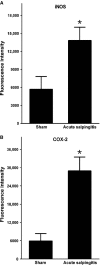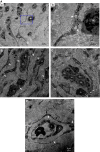Ultrastructure damage of oviduct telocytes in rat model of acute salpingitis
- PMID: 25753567
- PMCID: PMC4511368
- DOI: 10.1111/jcmm.12548
Ultrastructure damage of oviduct telocytes in rat model of acute salpingitis
Abstract
Acute salpingitis (AS) is an inflammatory disease which causes severe damage to a subset of classically described cells lining in oviduct wall and contributes to interstitial fibrosis and fertility problems. Telocytes (TCs), a newly discovered peculiar type of stromal cells, have been identified in many organs, including oviduct, with proposed multiple potential bio-functions. However, with recent increasing reports regarding TCs alterations in disease-affected tissues, there is still lack of evidence about TCs involvement in AS-affected oviduct tissues and potential pathophysiological roles. We presently identified normal TCs by their characteristic ultrastructural features and immunophenotype. However, in AS-affected oviduct tissues, TCs displayed multiple ultrastructural damage both in cellular body and prolongations, with obvious loss of TCs and development of tissue fibrosis. Furthermore, TCs lose their interstitial 3-D network connected by homocellular or heterocellular junctions between TCs and adjacent cells. And especially, TCs connected to the activated immunocytes (mononuclear cells, eosinophils) and affected local immune state (repression or activation). Meanwhile, massive neutrophils infiltration and overproduced Inducible Nitric Oxide Synthase (iNOS), COX-2, suggested mechanism of inflammatory-induced TCs damage. Consequently, TCs damage might contribute to AS-induced structural and reproductive functional abnormalities of oviduct, probably via: (i) substances, energy and functional insufficiency, presumably, e.g. TC-specific genetic material profiles, ion channels, cytoskeletal elements, Tps dynamics, etc., (ii) impaired TCs-mediated multicellular signalling, such as homeostasis/angiogenesis, tissue repair/regeneration, neurotransmission, (iii) derangement of 3-D network and impaired mechanical support for TCs-mediated multicellular signals within the stromal compartment, consequently induced interstitial fibrosis, (iv) involvement in local inflammatory process/ immunoregulation and possibly immune-mediated early pregnancy failure.
Keywords: acute salpingitis; fibrosis; immunoregulation; inflammatory factors; oviduct; rat model; stromal cells; telocytes; tubal ectopic pregnancy; tubal factor infertility.
© 2015 The Authors. Journal of Cellular and Molecular Medicine published by John Wiley & Sons Ltd and Foundation for Cellular and Molecular Medicine.
Figures





Similar articles
-
Telocytes in Inflammatory Gynaecologic Diseases and Infertility.Adv Exp Med Biol. 2016;913:263-285. doi: 10.1007/978-981-10-1061-3_18. Adv Exp Med Biol. 2016. PMID: 27796894 Review.
-
Telocytes damage in endometriosis-affected rat oviduct and potential impact on fertility.J Cell Mol Med. 2015 Feb;19(2):452-62. doi: 10.1111/jcmm.12427. Epub 2014 Nov 11. J Cell Mol Med. 2015. PMID: 25388530 Free PMC article.
-
Tubal telocytes: factor infertility reason?Folia Med Cracov. 2016;56(2):17-23. Folia Med Cracov. 2016. PMID: 28013318 Review.
-
Identification of telocytes in the oviduct of the mare.Theriogenology. 2023 Jul 15;205:18-26. doi: 10.1016/j.theriogenology.2023.04.012. Epub 2023 Apr 14. Theriogenology. 2023. PMID: 37084500
-
Telocytes: novel interstitial cells present in the testis parenchyma of the Chinese soft-shelled turtle Pelodiscus sinensis.J Cell Mol Med. 2015 Dec;19(12):2888-99. doi: 10.1111/jcmm.12731. J Cell Mol Med. 2015. PMID: 26769239 Free PMC article.
Cited by
-
Repeated hyperstimulation affects the ultrastructure of mouse fallopian tube epithelium.J Reprod Dev. 2020 Aug 20;66(4):387-397. doi: 10.1262/jrd.2019-147. Epub 2020 Apr 28. J Reprod Dev. 2020. PMID: 32350229 Free PMC article.
-
Electron microscopy of human fascia lata: focus on telocytes.J Cell Mol Med. 2015 Oct;19(10):2500-6. doi: 10.1111/jcmm.12665. Epub 2015 Aug 27. J Cell Mol Med. 2015. PMID: 26311620 Free PMC article.
-
Distribution characteristics and morphological comparison of telocytes in the aortic bulb and myocardium of yak heart.BMC Vet Res. 2025 Feb 22;21(1):88. doi: 10.1186/s12917-025-04553-x. BMC Vet Res. 2025. PMID: 39987074 Free PMC article.
-
Forty years of development of salpingitis animal modeling.Arch Gynecol Obstet. 2023 Oct;308(4):1093-1112. doi: 10.1007/s00404-023-06966-1. Epub 2023 Feb 17. Arch Gynecol Obstet. 2023. PMID: 36797525 Review.
-
Ultrastructural evidence for telocytes in equine tendon.J Anat. 2021 Mar;238(3):527-535. doi: 10.1111/joa.13335. Epub 2020 Oct 18. J Anat. 2021. PMID: 33070316 Free PMC article.
References
-
- Pearlman MD, McNeeley SG, Frank TS, et al. Antiendotoxin antibody is protective against tubal damage in an Escherichia coli rabbit salpingitis model. Am J Obstet Gynecol. 1994;171:1588–93. - PubMed
-
- Suciu L, Popescu LM, Gherghiceanu M, et al. Telocytes in human term placenta: morphology and phenotype. Cells Tissues Organs. 2010;192:325–39. - PubMed
Publication types
MeSH terms
Substances
LinkOut - more resources
Full Text Sources
Other Literature Sources
Research Materials

